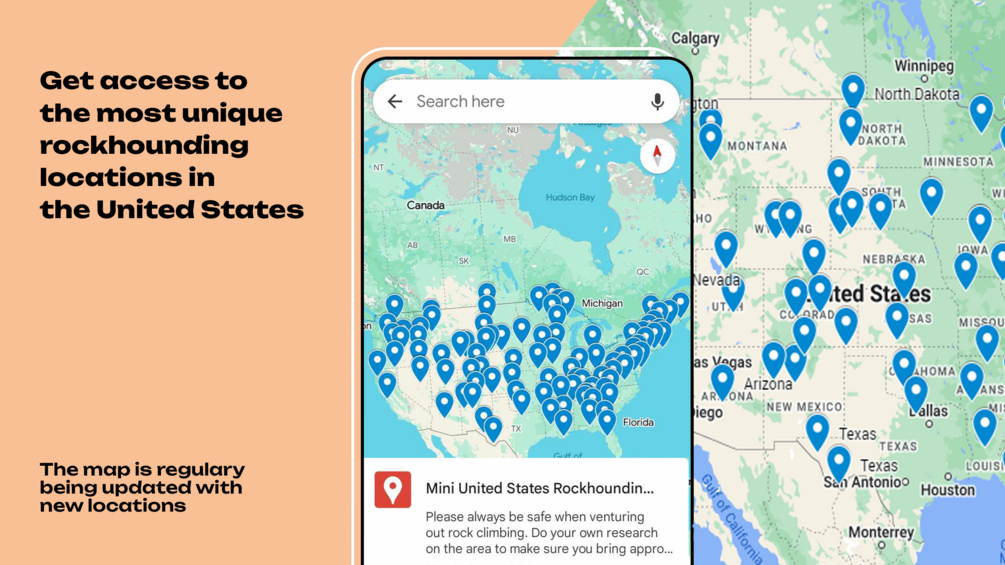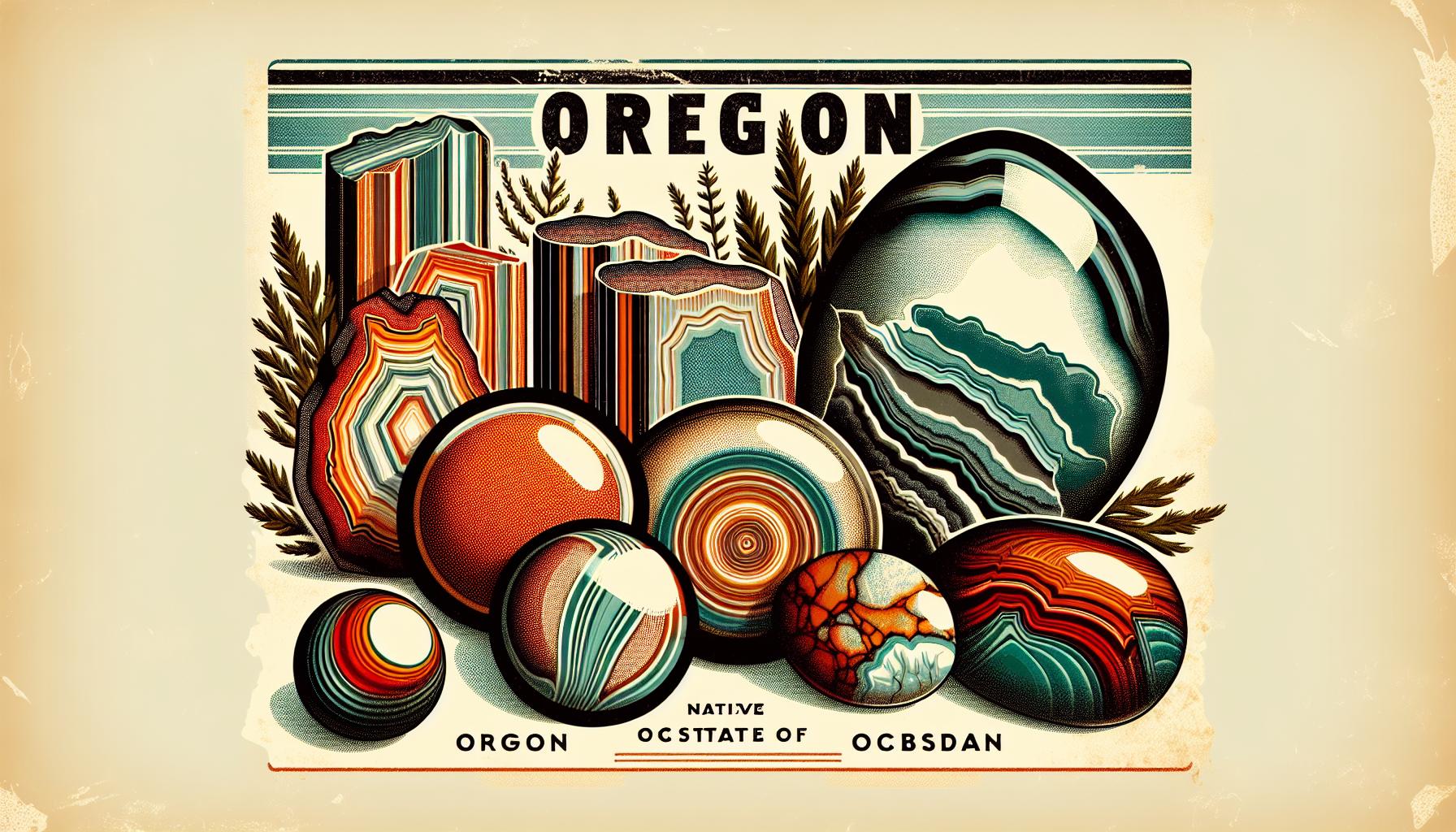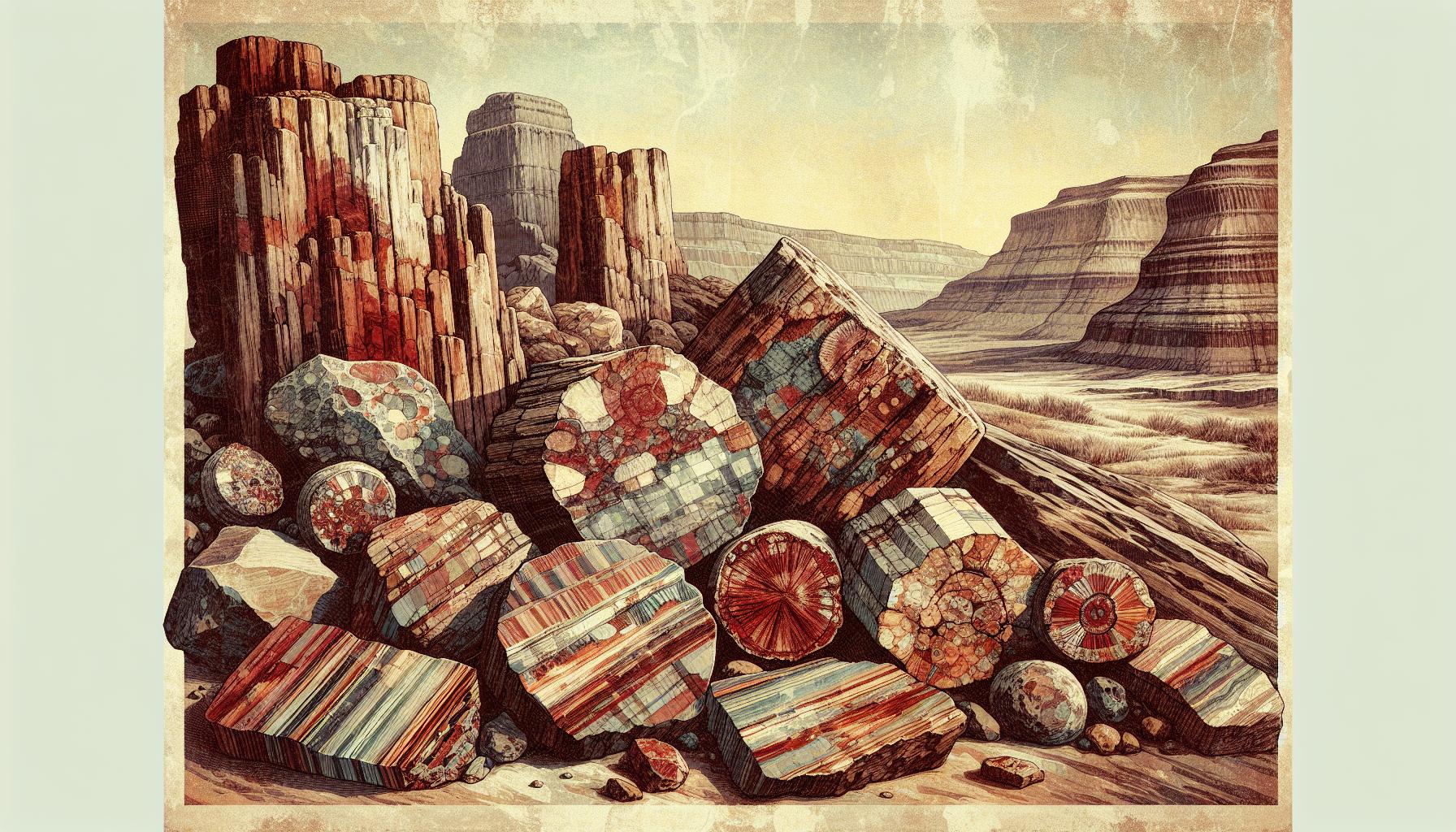Oregon’s rugged beauty isn’t just skin deep; beneath the surface lies a treasure trove for rockhounds.
You’re about to discover the best spots across the state where you can unearth your own natural souvenirs. From sunstone in the high desert to agate on the misty coastline, Oregon’s diverse geology offers a rich playground for beginners and seasoned collectors alike.
Whether you’re looking to fill your pockets with jasper, hunt for petrified wood, or find that perfect thunder egg, the Beaver State’s unique landscapes hold hidden gems just waiting to be discovered.
Get ready to explore the top rockhounding locations where each find tells a story millions of years in the making.
In Oregon, rockhounds find thunder eggs in Central Oregon, sunstones in Eastern Oregon, and agates on Northwest beaches. The Wheeler High School Fossil Beds offer plant fossils, while the Ochoco Mountains yield green jasper and Ochoco agates. Ensure successful rockhounding by respecting property rights and checking local regulations.
Get our FREE United States Rockhounding Map HERE

Oregon Rockhounding Locations
When you’re setting out on your rockhounding adventure, knowing where to look is half the battle. Across Oregon, there are several prime spots that beckon with the promise of interesting finds.
Central Oregon is renowned for its abundance of thunder eggs, the state rock of Oregon. Visit the Richardson Ranch in Madras to uncover these geological wonders. You can also explore the public lands around Prineville, where rockhounds often find agates, jaspers, and petrified wood.
Eastern Oregon offers a different landscape with the chance to discover sunstones at the Spectrum Mine near Plush. These are the state’s official gemstones, and the shimmering feldspar crystals you can dig up are truly unique.
In Northwest Oregon, the beaches near Newport are a haven for agate hunters. The winter storms churn up the ocean floor, casting a variety of agates onto the sand. Beachcombing after a storm can yield not just agates but also fossils and petrified wood.
If you’re curious about fossils, the Wheeler High School Fossil Beds in the town of Fossil allow visitors to search for ancient plant imprints. It’s an extraordinary experience to unearth a piece of history that’s millions of years old.
Moving south, the Graves Mountain area near the town of Sweet Home is a good spot to find thunder eggs and geodes. You’ll discover a range of colors and patterns, each one a hidden treasure waiting to be cracked open.
Lastly, don’t miss the opportunity to stop by the Ochoco Mountains. This area is famous for its stunning green jaspers and the sought-after Ochoco agates. You may need to hike to more remote spots, but the rewards can be fascinating.
Each location presents its own set of geological wonders:
| Location | Finds |
|---|---|
| Central Oregon | Thunder eggs, agates, jasper, petrified wood |
| Eastern Oregon | Sunstones |
| NW Oregon Beaches | Agates, fossils, petrified wood |
| Wheeler High School Fossil Beds | Plant fossils |
| Graves Mountain area | Thunder eggs, geodes |
| Ochoco Mountains | Green jasper, Ochoco agates |
What Gemstones are Found in Oregon?

Oregon’s landscape isn’t only rich with breathtaking scenery; it’s a treasure trove for rockhounds in search of precious and semi-precious gemstones. When you set out on your rockhounding adventure, you’re delving into an area renowned for its unique and diverse geological formations.
Sunstones are among Oregon’s most prized finds. They’re a feldspar crystal that can range from water-clear to bright red, green, or even bi-colored, and you’ll mainly find them in the southeastern part of the state. The Oregon sunstone is particularly unique due to its copper inclusions, giving it an additional sparkle unlike any other variety found in the world. The Plush Sunstone area, in particular, is famous for these radiant gems.
Oregon’s beaches are another hotspot. Here, you can scour the sands for Agates—beautiful, translucent stones often seen with bands of color, which are highly sought after by jewelers and collectors alike. You might also encounter Jasper, a type of chalcedony known for its rich, patterned designs and earthy colors, which is quite prevalent along the riverbeds and coasts.
Heading into the regions known for volcanic activity, you’re likely to stumble upon Obsidian. This natural volcanic glass forms sharp edges and has been fashioned into tools and weapons by indigenous peoples for thousands of years. Its dark, shiny appearance makes it easily identifiable.
| Gemstone | Typical Color | Location in Oregon |
|---|---|---|
| Sunstone | Red, green, bi-colored | Southeastern Oregon |
| Agate | Banded, various colors | Oregon beaches |
| Jasper | Red, yellow, brown | Riverbeds and coastal areas |
| Obsidian | Black, dark green | Volcanic regions |
In addition to these, rockhounds often find Opals, which are valued for their shifting play of kaleidoscopic colors. Places like the Juniper Ridge opal mine in Lake County allow you to dig for these mesmerizing stones.
If you’re after something even more unique, you might be lucky enough to find Thunder Eggs, Oregon’s official state rock. These spherical geological structures can contain a center filled with agate, opal, jasper, or crystal quartz.
What Sedimentary Rocks You Can Find in Oregon?

As you explore Oregon’s varied landscapes for geological treasures, you’ll find that sedimentary rocks play a starring role in the state’s geological repertoire. Sedimentary rocks, formed over millions of years from the accumulation and lithification of mineral and organic material, offer a glimpse into Oregon’s ancient environments.
Petrified wood is one of the tantalizing sedimentary finds in this state. The high desert of Eastern Oregon, particularly around the town of Hampton, is known for yielding well-preserved specimens. These remnants of prehistoric forests have transformed into stone, displaying intricate patterns and a spectrum of colors from vibrant reds to muted browns.
Venture to the coastal cliffs and you may chance upon sandstone and shale. Formed from compressed sands and mud, these sedimentary rocks are prominent in the Clarno Formations and are often accompanied by the telltale signs of past life – fossils. Rockhounds delight in uncovering leaf impressions and other fossilized flora that speak to Oregon’s lush history.
In the Willamette Valley, you can find siltstone, a finer-grained cousin of sandstone. This rock often contains minute particles of quartz and feldspar, telling of quiet waterways and gentle depositional environments from times gone by. Siltstone layers can reveal delicate stratifications, recording the ebb and flow of Oregon’s ancient water bodies.
Limestone is another sedimentary treasure that awaits in Oregon’s geological mosaic. Predominantly found in the Eastern part of the state, limestone is primarily composed of calcite and can occasionally harbor marine fossils. These relics, encased in stone, offer a snapshot of ancient seas that once covered the region.
Armed with your hammer and chisel, you can delve into the sedimentary layers and unearth pieces of Earth’s distant past. Each rock tells a story, and in Oregon, the narratives are rich and plentiful. Keep a lookout for these sedimentary specimens as they’re not just stones but the pages of the planet’s grand history book.
What Metamorphic Rocks are found in Oregon?
Exploring Oregon’s geology, you’ll discover an array of metamorphic rocks that have been reshaped by heat and pressure. Marble, schist, and quartzite are just a few examples of what you might find. The state’s complex geologic history has created prime conditions for these rocks to form, offering a thrilling hunt for avid rockhounds.
Marble
Enthusiasts often seek out the metamorphosed form of limestone known as marble. Typically white, it can also show off other colors due to various mineral impurities. Oregon’s marble can be sourced from sites such as the Lucy Gray Quarry. This location is known for its quality specimens suitable for collectors and artists alike.
Schist
With its pronounced layering, schist is a result of intense metamorphosis, where clay-rich rocks were altered under substantial heat and pressure. In Oregon, schist can be found in regions rich with tectonic activity, like the Klamath Mountains. These mountains are a treasure trove, with various minerals woven into the fabric of the rock, such as garnet and staurolite.
Quartzite
Hard and durable, quartzite forms when quartz-rich sandstone is altered by metamorphism. In Oregon, look for areas where the original sandstone formations are known to exist, as these are favourable spots for finding quartzite. It’s common in the Blue Mountains where prospectors may also encounter traces of gold.
Remember to check land ownership before rockhounding, as different areas may have varying regulations. Private lands, state parks, and national forests all have unique rules you’ll need to follow. Stay informed, and your rockhounding adventure in Oregon will not only be rewarding but also responsible. Whether you’re a seasoned rockhound or new to the hobby, these metamorphic treasures are a testament to Oregon’s dynamic geological processes and are waiting to be unearthed by those with a keen eye and a bit of patience.
What Igneous Rocks can You Find in Oregon?
Igneous rocks form a crucial component of Oregon’s geological tapestry, bearing witness to the state’s fiery volcanic past. As a rockhound, you’ll be thrilled to discover the diversity of igneous specimens scattered throughout the landscape.
Central Oregon is particularly renowned for its abundance of obsidian. This glass-like volcanic rock is often sought after for its sharp edges and mesmerizing sheen. Glass Buttes is a must-visit locality where you’ll find obsidian in a variety of colors, from jet-black to mahogany and even rainbow-hued.
If you’re fascinated by the intricate designs of agate, the region won’t disappoint. Oregon’s agates, with their concentric bands of color, are predominantly found along the beaches and riverbanks, especially around Newport and the mouth of the Big Nestucca River. These areas provide not only agates but also jasper, a vibrant, opaque quartz variety that often accompanies agate deposits.
Volcanic activity has also blessed Oregon with plentiful deposits of basalt. The Columbia River Gorge and the Portland Basin host extensive basalt flows. This fine-grained rock is typically dark in color and solidifies from lava that has flowed and cooled.
For a truly unique find, keep your eye out for thundereggs, Oregon’s state rock. These spherical formations aren’t visually striking on the outside but slice them open to reveal a kaleidoscope of mineral deposits, like quartz or chalcedony. Thundereggs can be hunted at the Richardson Rock Ranch, where digging pits are open to the public for a small fee.
Remember to always secure permission if you’re venturing onto private property. Additionally, be mindful of regulations when collecting in state parks or national forests. This will ensure you can enjoy your rockhounding experience without any legal hiccups.
By understanding where these igneous treasures lie, you’re well on your way to adding some exceptional pieces to your collection. Get ready to explore Oregon’s igneous offerings and unearth the geological history hidden within each stone.
Panning for Gold in Oregon
When plunging into the world of rockhounding in Oregon, panning for gold is an alluring adventure you don’t want to miss. Throughout history, prospectors have been drawn to Oregon’s rich rivers and streams in search of the elusive glint of gold. Here’s your chance to join the ranks, pan in hand, and eyes peeled for that precious yellow metal.
Oregon has several rivers and creeks known for placer gold deposits. Hit the Rogue River for its historically gold-rich waters, especially around Gold Hill and Grants Pass. You might also want to explore the Applegate River and its tributaries, which have been popular havens for gold panners since the 1850s.
Before you embark on your gold panning journey, there are a few things you should be aware of:
- Always verify land ownership and mining rights to ensure you’re panning legally.
- Respect private claims, and never pan without permission.
- A simple gold pan and a few hand tools are all you need to start.
For beginners, the areas around Eastern Oregon’s Blue Mountains are a great starting point. The Powder River, Granite Creek, and Burnt River welcome novice panners with relatively uncomplicated terrain and gold deposits that are easy to navigate.
If you’re looking for a more guided experience, numerous outfits in Oregon offer day trips complete with tutorials and equipment. These excursions can be a fantastic way to familiarize yourself with panning techniques while ensuring you’re in an area with a known history of gold.
While the possibilities of striking it rich are slim, the true treasure lies in the experience itself. Imagine standing knee-deep in a cool river, surrounded by the stunning Oregon landscape, with nothing but the sound of the water and your anticipation of discovering gold. It’s this combination of natural beauty and the thrill of discovery that keeps gold panning in Oregon a timeless pursuit.
Rocks and Minerals Found in Oregon
Oregon’s diverse geology makes it a treasure trove for rockhounding enthusiasts. Sedimentary, metamorphic, and igneous rocks are scattered generously across the state, offering a rich palette for collectors.
In the sedimentary category, petrified wood is a remarkable find, transforming from wood to stone over millions of years. You’ll discover pieces that range in color from chocolate brown to rainbow hues, each telling a story from Oregon’s ancient past. Sandstone, shale, and siltstone are also present, showcasing the varied environments that have existed in this region.
Turning to metamorphic treasures, Oregon boasts a variety of rocks such as marble, schist, and quartzite. Marble, with its crystalline texture and beauty, can be found in the western part of the state where metamorphism has altered limestone deposits. Schist and quartzite, formed under tremendous pressure and heat, provide a glimpse into the intense geological processes that shape our planet.
On the igneous side, you’ll discover obsidian, known for its glass-like appearance and sharp edges, commonly used by Native Americans for tools and weapons. Additionally, agate, with its banded patterns, provides rockhounds with striking specimens perfect for polishing. Igneous rocks such as basalt and thundereggs, which are uniquely Oregonian, are also abundant. Thundereggs, Oregon’s official state rock, hold a fascination for collectors due to the mineral patterns hidden within.
| Rock Type | Locations | Characteristics |
|---|---|---|
| Sedimentary | John Day Fossil Beds | Petrified wood, rich historical significance |
| Metamorphic | Western Oregon | Marble, Schist, and Quartzite, indicators of ancient geological activities |
| Igneous | Central & Eastern Oregon | Obsidian, Agate, and Thundereggs, diverse and aesthetically appealing |
Whether you’re drawn to the history embedded in sedimentary layers, the transformation stories within metamorphic rocks, or the fiery birth of igneous stones, Oregon’s landscape is your canvas. Remember to respect the environment and secure the appropriate permissions as you embark on expeditions to unearth these natural treasures.
Where Can I Find Fossils in Oregon?
Oregon, with its varied geology, isn’t just a haven for rockhounders searching for rocks and minerals; it’s also fertile ground for fossil enthusiasts. The richness of the state’s prehistoric life is encapsulated in the numerous fossil beds scattered throughout the region.
Fossilized remains from millions of years ago promise an exciting adventure for anyone looking to delve into the distant past. Whether it’s the search for plant imprints or the thrill of uncovering mammal bones, Oregon’s fossil sites are diverse and plentiful.
- Beverly Beach State Park: Here you can find fossils of ancient shells and marine life embedded in the coastal rocks.
- Wheeler High School in Fossil: Navigate to the school’s designated fossil beds where you’re allowed to collect leaf imprints and other plant fossils.
- Thomas Condon Paleontology Center: Located in the John Day Fossil Beds National Monument, this site offers a magnificent display of fossils and aids in understanding the types of species that can be discovered in the region.
- The Fossil Beds of Hampton Butte: Cater to those seeking petrified wood and fossilized remains of plants and animals from the Pliocene and Miocene epochs.
While exploring fossil sites, you’ll find that each location has its own rules and regulations regarding the collection of fossils. It’s vital to familiarize yourself with these to ensure your fossil hunting is legal and ethical.
Remember to bring the necessary tools for fossil hunting, including a geologist’s hammer, chisels, and brushes. A magnifying glass or a hand lens will help you examine your finds with greater detail on site. Be sure to wear sturdy gloves to protect your hands while working with rocks and tools.
The terrain in Oregon can be rugged, so proper footwear and clothing are essential. Always be conscious of the weather forecast and terrain to prepare adequately for your fossil hunting trip.
Most importantly, bear in mind that collecting fossils, like rockhounding, is a privilege. Respecting the environment, securing permissions where necessary, and adhering to collection limits will ensure that these natural treasures continue to be available for generations to come.
Oregon Rockhounding Laws & Regulations
When planning your rockhounding adventure in Oregon, it’s crucial to be aware of the state’s laws and regulations that govern the collection of rocks, minerals, and fossils. Understanding these rules ensures that your hobby remains a joy and doesn’t lead to any legal complications.
Public Lands and National Forests typically allow rockhounding for personal use in small quantities, but commercial collection is prohibited without a permit. Your find should be for non-commercial purposes, and there’s usually a limit on the amount you can collect in a day—often no more than a gallon. For exact guidelines, check with the Bureau of Land Management (BLM) or US Forest Service before your trip.
In Oregon, State Parks are generally off-limits for rockhounding to protect natural features and wildlife habitats. However, specific sites may have designated areas for collecting. Always respect signage and visitor regulations at each park.
Private Land requires permission from the landowner before you can dig or remove any rocks. Trespassing for rockhounding without consent is illegal and can result in hefty fines.
Heading into Oregon’s diverse landscape, you should also be mindful of Native American artifacts. If you encounter any, it’s illegal to collect them. These items are protected under the Archaeological Resources Protection Act (ARPA), emphasizing the cultural and historical significance they hold.
Here’s a quick checklist to ensure you’re rockhounding responsibly in Oregon:
- Verify if the area allows collecting and the limits.
- Obtain any necessary permits or permissions.
- Stay informed about the types of rocks, minerals, and fossils you’re allowed to collect.
- Leave no trace and minimize environmental impact.
- Avoid restricted areas and respect private property.
By following these guidelines, you’ll contribute to the sustainability and longevity of rockhounding in Oregon. Plus, you’ll enjoy the rewards of your hobby without infringing on regulations or damaging sensitive ecosystems. Remember that each location may have unique rules, so it pays to do your research before setting out on your quest for Oregon’s geological treasures.
Rockhounding Tips for Beginners in Oregon
Gearing Up: Essential Tools for Rockhounding
Embarking on a rockhounding adventure requires more than just enthusiasm; you need the right gear. A basic set of tools can greatly enhance your experience and protect your finds. Consider these essentials:
- Rock Hammer: The quintessential tool for any rockhound, a sturdy rock hammer will help you chip away material and split rocks.
- Safety Goggles: Protect your eyes from flying debris when chipping or breaking rocks.
- Chisels and Picks: For precise work and extracting specimens from the host rock.
- Field Guide: A good field guide will assist in identifying rocks, minerals, and fossils.
- Backpack: Carry your tools and finds safely.
- Sturdy Gloves: Protect your hands from sharp edges and rough surfaces.
- Collection Bags or Containers: Separate and protect your specimens as you find them.
Remember, the nature of the terrain and the specific rocks you’re after may require specialized equipment. Research your destination and prepare accordingly.
Safety Tips While Rockhounding
Safety should always come first when rockhounding. Sharp rocks, rugged terrain, and remote locations present potential hazards, so be prepared:
- Stay Hydrated: Carry plenty of water, especially during the warmer months. Oregon’s rugged terrain can be challenging and dehydration is a risk.
- Appropriate Footwear: Wear boots or shoes with good ankle support and grip to navigate rocky areas safely.
- Weather-Appropriate Clothing: Dress in layers and be prepared for sudden weather changes, a common occurrence in Oregon.
- First-Aid Kit: It’s important to have a basic first-aid kit for cuts, scrapes, or other minor injuries.
- Tell Someone Your Plans: Always inform someone about your rockhounding location and expected return time.
- Be Wildlife Aware: Knowing how to respond to wildlife encounters is crucial, particularly in less traveled areas where animals are present.
Legal Guidelines for Rockhounding Enthusiasts
Understanding and adhering to the legal aspects of rockhounding will ensure that you enjoy a hassle-free hobby. Here’s what you need to know about the legal guidelines in Oregon:
- Land Ownership: Always determine if the land is public or private and seek permission accordingly.
- Permits: Some areas may require permits for collecting. Check with local agencies before your trip.
- Collection Limits: Public lands usually have specific limits on the quantity and type of materials you can collect.
- Cultural Artifacts: It’s illegal to collect Native American artifacts or disturb archeological sites.
- Leave No Trace: Practice the ‘Leave No Trace’ principles to help preserve the natural beauty of rockhounding locations for future generations.
- Stay Informed: Laws and regulations can change, so stay up to date by consulting with local land management agencies before each trip.
By considering these factors, you’re setting yourself up for a rewarding experience in the diverse landscape of Oregon. Whether you’re seeking vibrant agates, the volcanic glow of obsidian, or the prehistoric allure of petrified wood, Oregon’s rich geology offers a unique adventure into the past with every rock, mineral, and fossil waiting to be discovered.
Conclusion: Oregon Rockhounding Map
Oregon’s diverse geological landscape offers you a treasure trove of rockhounding opportunities.
Whether you’re drawn to the rich hues of agates, the unique formations of thundereggs, or the glint of gold in a creek, you’ll find a spot that suits your interests. Remember to arm yourself with the right tools, knowledge of the area, and a respect for the land and its regulations. With responsible practices, you can ensure these natural wonders remain intact for future generations of rockhounds. So grab your gear, secure the necessary permissions, and set out on an adventure that marries the beauty of Oregon’s outdoors with the excitement of unearthing its hidden gems.
Happy rockhounding!



![Kentucky Rockhounding Sites in [year]: Gems & Fossils](https://observationhobbies.com/wp-content/uploads/2024/01/NGGUoQCpBPbnhxaNgdSE2-768x439.jpg)



